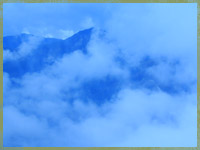 Bhutan
is an ecological wonder. Within an area roughly the size of
Switzerland, rising from the Indian plains to the Tibetan plateau,
is a natural landscape of immense beauty and diversity. Folds
of forested hills, rugged cliffs, fast rivers and young valleys
fall from high snow-covered peaks. Austere barren expanses stretch
between colossal luminous veined mountains. Patchwork fields
of subtly contrasting hues nestle within spontaneous kaleidoscopic
vegetation. There are a great variety of individual locales,
differentiated by their particular combination of altitudinal,
climatic and topographical conditions. These harbor a wealth
of flora and fauna, the sheer mass and variety of which is almost
unparalleled within such a limited space: giant rhododendron
and rare orchid, majestic tiger and quirky takin, colorful pheasant
and graceful black-necked crane. Bhutan
is an ecological wonder. Within an area roughly the size of
Switzerland, rising from the Indian plains to the Tibetan plateau,
is a natural landscape of immense beauty and diversity. Folds
of forested hills, rugged cliffs, fast rivers and young valleys
fall from high snow-covered peaks. Austere barren expanses stretch
between colossal luminous veined mountains. Patchwork fields
of subtly contrasting hues nestle within spontaneous kaleidoscopic
vegetation. There are a great variety of individual locales,
differentiated by their particular combination of altitudinal,
climatic and topographical conditions. These harbor a wealth
of flora and fauna, the sheer mass and variety of which is almost
unparalleled within such a limited space: giant rhododendron
and rare orchid, majestic tiger and quirky takin, colorful pheasant
and graceful black-necked crane.
More remarkable still is the manner in which entire ecosystems
remain relatively uncompromised by human activity. There is
little evidence in Bhutan of teeming masses uncontrollably
jostling for tenuous positions or the commanding technological
innovations with which man has wrested control of his environment
from Mother Nature. Most inhabitants still realize a simple
sustainable existence within their dominant natural settings.
The inhospitable mountainous backdrop serves to both inhibit
whole scale human encroachment and accentuate the primacy
of the natural world. Ecology thus survives in all its immense
complex multidimensional totality, perpetually interacting
within understated natural habitats and relatively stable
hierarchies.
Such is its global significance that the natural environment
has become a central pillar of Bhutan's national identity.
Ongoing government commitments to conservation are uncommonly
strong and have achieved some notable successes. However,
that current conditions remain so preserved is in no small
part a product of the country's underdevelopment. A host of
new pressures are emerging that have the potential to seriously
compromise environmental integrity. A National Environment
Strategy has been articulated which aims at following a 'Middle
Path', maintaining a suitable balance between the respective
and often contradictory priorities of development and conservation.
Achieving this goal amidst the plethora of chaotic, uneven
and inherently destabilizing modernizing processes however
remains exceptionally problematic.
|



